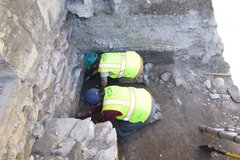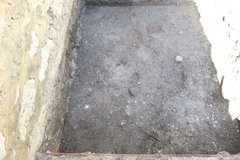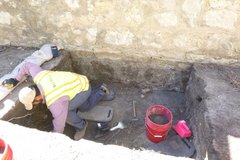Four excavation units were active during the week of February 19. Archaeologists continued to work in EUs 2B, 6, 10, and 12.
Within EU-2B archaeologists excavated to an approximate depth of 80 cm below surface. During excavations archaeologists were able to further delineate the limestone feature initially encountered in EU-3. The feature does appear to extend to the south, but was impacted by the installation of a utility conduit as noted last week. The alignment may have been an informal wall installed by the US Army in the latter half of the 1800s. The alignment is comprised of stacked limestone and mortar, however there is not a formal footer or foundation.
Archaeologists in EU-6 reached approximately 130 cm below surface, which was within a sterile silty clay.





